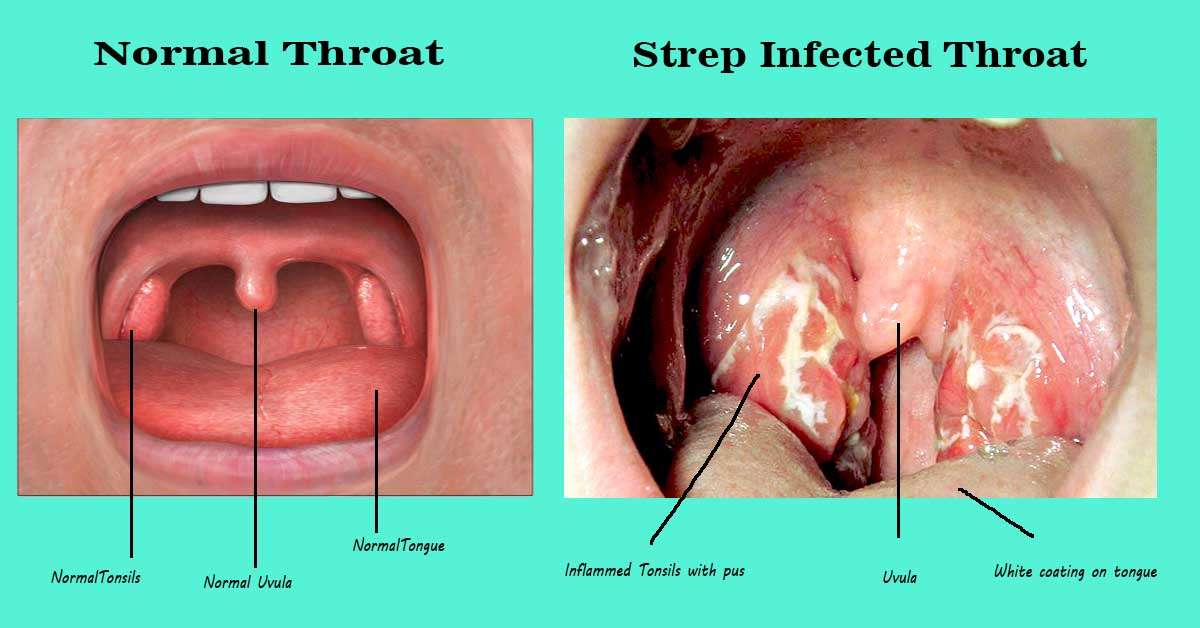Do you want to know about strep throat infection and its Pathophysiology? It can cause more complications if not treated. Do you really want to know how to deal with a Strep throat infection? What kind of precautions and treatment should be taken? Then you are requested to read this article carefully and share it with your friends to avoid strep throat infection in the future.
Your throat may feel scratchy and sore if you have strep throat, a bacterial infection. Streptococcus is responsible for only a small percentage of sore throats. Streptococcus pyogenes, well known as group A streptococcus, is the bacterium that causes strep throat. Streptococcal bacteria are extremely contagious. They can be spread through shared food or beverages and droplets from coughing and sneezing. Doorknobs and other surfaces can transmit bacteria to the mouth, nose, and eyes.
Streptococcus pharyngitis is most common in children but can happen to anyone. Children age group 5 to 15 are especially vulnerable. Strep throat, like other illnesses, is spread through close contact. Sneezing, coughing, sharing eating utensils, and other close contacts can all lead to the spread of Strep. Complications from untreated strep throat can include kidney inflammation and rheumatic fever. A specific rash, heart valve damage, and painful, inflamed joints characterize rheumatic fever.
Strep Throat Evaluation
The doctor will go over your symptoms with you. Only testing reliably distinguishes Strep from other viruses that cause sore throats. There are two types of tests:
Rapid streptococcal test Case identification takes only a few minutes. The physician will use a tongue depressor to press the patient’s tongue down gently. A sample can be taken from the back of the throat and swabbed with cotton. Receive the results in less than 20 minutes. If the test results show that Strep is present, the doctor will prescribe antibiotics to treat the infection.

Culture of the Throat: To obtain a sample for the laboratory, the doctor will rub a swab over the tonsils and throat. Streptococci bacteria will grow in the throat of a strep throat patient. The results of a throat culture are usually available in two to three days. It can tell whether a patient has strep throat or not.
Complications caused by Strep Throat
Streptococcal complications are now uncommon due to advances in diagnosis and treatment. Untreated strep can, however, cause serious complications such as:
- Infection of the tonsils, sinuses, middle ear, mastoiditis, skin, or blood.
- A pus-filled swelling around the tonsils or behind the neck, known as a peritonsillar abscess, can cause excruciating pain.
- Scarlet fever, a red rash that can appear as small, difficult-to-see pinpricks or as intense redness on the body, as the name suggests.
- Rheumatic fever can cause joint, heart, and brain damage.
- Glomerulonephritis, a kidney disorder;
Another uncommon and poorly understood complication is Pediatric Autoimmune Neuropsychiatric Disorders Associated with Streptococcal Infections. Obsessive-compulsive disorder (OCD) tics and habits typically manifest after a strep infection, or OCD symptoms typically worsen.
Teardrop-shaped scales distinguish guttate psoriasis on the skin’s surface. They could be itchy, red, or silver.
Strep Throat Treatment
If you or your child has a fever, keep them home from school or daycare for at least 24 hours and give them an antibiotic. The same can be said for the workplace.
- Do not give sick people your cups, dishes, forks, or other personal items.
- Require all household members to wash their hands frequently or use an alcohol-based hand sanitizer throughout the day.
- Tell children to use a tissue or sleeve to cover their coughs and sneezes.
How to Relieve Strep Throat Pain
There are lot of methods which can help to treat strep throat infection but we will discuss more useful methods to alleviate the strep throat infection.
Treatment Method 1:
Symptoms of strep throat, a common bacterial infection, include throat soreness, fever, headache, difficulty swallowing, red and swollen tonsils, and hoarseness when speaking. Even though a doctor must diagnose strep throat and prescribe different remedies immediately to relieve symptoms, you can alleviate the discomfort associated with strep throat by combining these treatments and increasing humidity in your environment.
Using Natural Therapies
- Gargle with one cup (240 mL) of water and half a teaspoon of salt. Gargling with salt water for 30 seconds can reduce inflammation and pain in the throat for up to two hours. Young children are unlikely to be able to gargle other pain-relieving methods should use. When you’re finished gargling, spit it into the sink.
- Drink one cup of warm water mixed with two tablespoons (30 milliliters) of honey. Stir the honey into the water until it is mostly dissolved. Like a cup of tea, the water should be warm but not hot. Unpasteurized honey may contain bacteria that cause botulism. Honey’s antibacterial, anti-inflammatory, and cough-suppressant properties make it an excellent treatment for strep throat. Because their immune systems are still developing, avoid honey to give to infants under the age of one year.
- Combine 1 cup (240 mL) of warm water and one teaspoon (4.9 mL) of lemon juice in a mixing bowl. Sip this mixture several times throughout the day as needed for pain relief. Lemon juice relieves pain and prevents infection by breaking up mucus and fortifying the immune system.

4. Drinking various teas can help with a variety of symptoms. Because so many different teas can be used as natural remedies for strep throat pain, the best tea to consume is largely determined by your personal taste preferences. Chamomile is the most well-known tea for soothing sore throats, and for a good reason. It is antibacterial and anti-inflammatory. Green tea can help soothe your throat by reducing inflammation. The natural numbing effect of peppermint tea on the throat can help relieve pain. It also acts as a natural lubricant, which helps those who have difficulty speaking or swallowing.
5. Eat foods that are easy to swallow, and avoid spicy and acidic foods. Soft foods, such as soups, applesauce, oatmeal, mashed potatoes, soft fruits, and soft-cooked eggs, will be much easier to consume than hard foods, which may irritate your sensitive throat. Cold foods like ice cream and frozen fruit can be soothing.
6. Get enough rest to help your immune system fight infection. Sleep is required for your immune system to function properly. Every night, get the recommended eight hours of sleep. It would be best to avoid tiring activities like working or exercising during the day. While contagious and experiencing strep throat symptoms, you should stay home to rest and prevent the illness from spreading.
7. Avoid environmental irritants that may harm your lungs. Examples are tobacco smoke, paint and cleaner fumes, air fresheners, and even some perfumes. Inhaling irritants can worsen your symptoms or spread the infection to your throat if you have strep throat. You can wear a medical face mask if you want to protect your mouth and nose from these irritants. Furthermore, you would be less likely to infect others due to this.
Treatment Method 2:
- Increased humidity in the atmosphere: Place a humidifier in your room to clear your sinuses and reduce swelling. Humidifiers are excellent for increasing the humidity in a room, which has numerous benefits for people who suffer from sore throats. The cold air dries out your sinuses, which are already inflamed by strep throat. Humidifiers warm the air and add moisture, which helps to clear the sinuses and relieve pain. When choosing a humidifier, there are several factors to consider. Examine humidifiers’ ability to add moisture to the air and their size, noise level, and price. For additional relief, add one tablespoon (15 mL) of hydrogen peroxide or vapor rub to the water in your humidifier.
- Take a long, hot shower. Take a long, hot bath. The steam’s moist air will cleanse your sinuses and airways, while the heat will relieve pain. Breathe deeply through your mouth and nose while taking a shower, but avoid doing so while your head is submerged in water.
- Take a deep breath of steam from a large bowl of boiling water. Place the bowl on a table and sit in front of it. Wrap a towel around your head to enclose both you and the bowl. Take a deep breath while the water cools. It should have the same effect as using a humidifier or taking a long bath.
Avoid getting burned by steam or getting in contact with hot water. Remove the towel if the underside becomes too steamy or hot to allow for ventilation.
Treatment Method 3:
1. Use of non-prescription medications:
Before taking any pain medication, consult a doctor or other healthcare provider. Some people are unable to take certain medications due to other health issues. Consult a doctor or other healthcare professional before using a non-prescription medication to treat sore throat pain.
2. Make use of a nonsteroidal pain reliever:
Take a nonsteroidal anti-inflammatory medication, such as ibuprofen, to reduce throat swelling. This class of medications, ibuprofen, naproxen, and acetaminophen is extremely effective at alleviating the severe sore throat pain associated with strep throat. A 200 mg or 400 mg starting dose every 6 to 8 hours is an effective starting point. Consult the medication’s instructions for the recommended dosages.
3. Consume acetaminophen (like generic Tylenol):
Acetaminophen can help with sore throat pain (like generic Tylenol). Acetaminophen is just as effective as ibuprofen in treating strep throat pain. Acetaminophen is preferable to ibuprofen if you have a history of ulcers, kidney disease, or acid reflux. Take 650 mg every four to six hours, up to a daily maximum of 4000 mg. When adjusting acetaminophen dosages, use extreme caution and stick to the recommended maximum daily doses.
4. Use Cough drops or throat lozenges:
A Strep throat-infected person should use a cough suppressant or a throat lozenge. Strep throat-infected children should not use tablets due to choking risks. To relieve sore throat symptoms, lozenges, and cough drops typically contain a combination of pharmaceutical and herbal ingredients that numb the throat and reduce inflammation. A Pectin 7mg lozenge, for example, can provide pain relief. Chew one until it dissolves in your mouth. Dissolve one tablet in your mouth every two hours. Sprays, gargles, and strips that can be placed on the tongue or in the back of the throat are other types of lozenges. Choose whatever works best for you.
5. Use the spray with 1.4% phenol Chloraseptic:
Use a spray containing 1.4% Phenol Chloraseptic, and the spray can be obtained without a prescription. The spray must be used five times above the age of 15 and three times below the age of 15 and above ten years. Spit it out after 15 seconds of holding the spray in your throat. Strep throat-infected persons can reapply every two hours. Use this spray for no more than two days. Before using the spray on children under three, consult a doctor.
6. Take mineral and vitamin supplements:
Take zinc, vitamin C, and vitamin D supplements to speed your recovery. Strengthening your immune system with vitamins C, D, and zinc will help your body fight a strep throat infection faster. Aim for 80-100 mg of vitamin C, 15 mcg of vitamin D, and up to 10 mg of zinc per day to maintain a healthy immune system. Vitamins and minerals are available through diet or supplementation.
Vitamin and mineral supplements can be purchased from a local pharmacy. Oranges, broccoli, peppers, and tomatoes are high in vitamin C. At the same time, dairy products, eggs, salmon, and oily fish are high in vitamin D. Vitamin D can also be obtained from sunlight, and zinc can be found in whole grains, shellfish, nuts, and seeds.
Treatment Method 4:
- Taking medication as prescribed by a doctor:
If you were given antibiotics, take them completely. When a patient has strep throat, doctors usually give penicillin or amoxicillin. Antibiotics are typically given for ten days at a time. Even if your sore throat resolves before the antibiotics expire, you should continue taking them for the full duration your doctor prescribes. Never give additional antibiotics to anyone else.
- Replace your toothbrush:
You should replace your toothbrush after 24 hours of taking antibiotics. Because the bacteria that cause strep are still present on your old toothbrush, you should replace it. If you have a toothbrush holder, clean it as well. When you have a contagious illness, do this.
- Obtain a Lidocaine prescription:
If you are over 12 and in severe pain, you should get a prescription for Lidocaine. Lidocaine 2% is a prescription-only topical anesthetic. It may alleviate throat discomfort. Lidocaine topical gels, sprays, and liquids are available. Follow your doctor’s orders and the Lidocaine’s instructions on how and when to use it. Avoid eating for one hour after applying Lidocaine to the throat.





